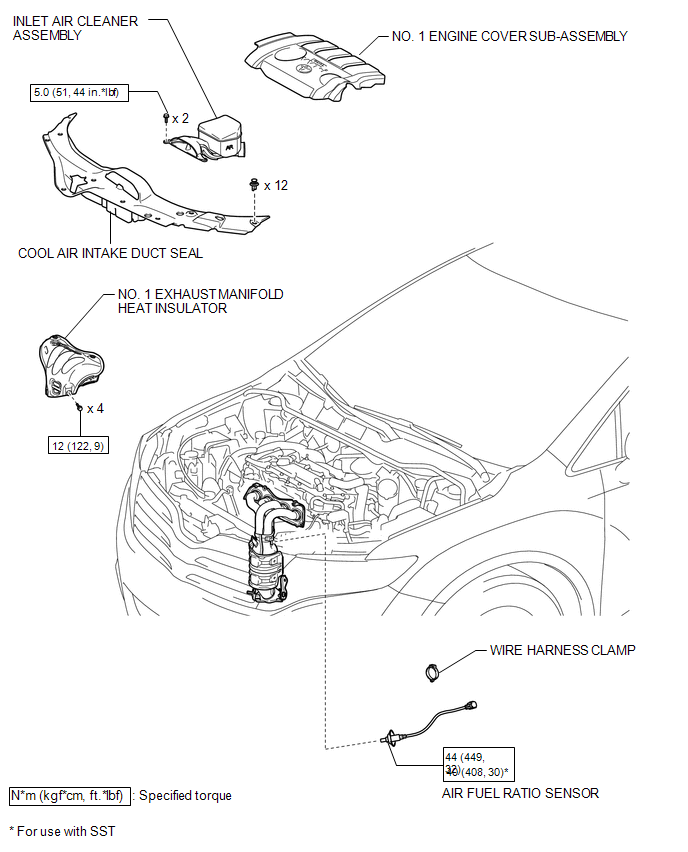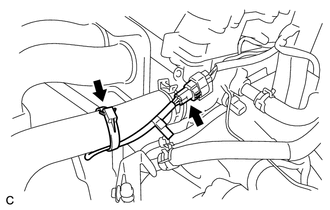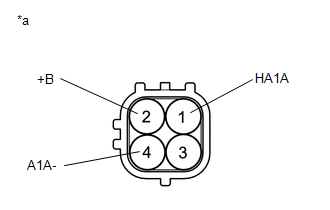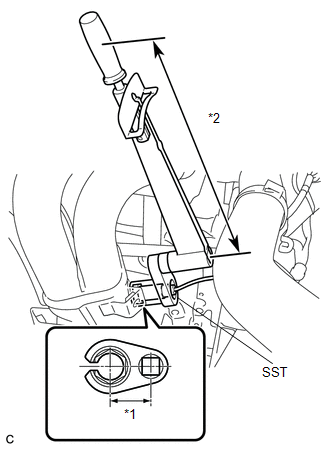Toyota Venza: Air Fuel Ratio Sensor
Components
COMPONENTS
ILLUSTRATION

Removal
REMOVAL
PROCEDURE
1. REMOVE NO. 1 ENGINE COVER SUB-ASSEMBLY
.gif)
2. REMOVE COOL AIR INTAKE DUCT SEAL
.gif)
3. REMOVE INLET AIR CLEANER ASSEMBLY
.gif)
4. REMOVE NO. 1 EXHAUST MANIFOLD HEAT INSULATOR
.gif)
5. REMOVE AIR FUEL RATIO SENSOR
|
(a) Disconnect the air fuel ratio sensor connector. |
|
(b) Remove the wire harness clamp.
|
(c) Using SST, remove the air fuel ratio sensor from the exhaust manifold. SST: 09224-00011 |
|
Inspection
INSPECTION
PROCEDURE
1. INSPECT AIR FUEL RATIO SENSOR (for Bank 1 Sensor 1)
|
(a) Measure the resistance according to the value(s) in the table below. Standard Resistance:
If the result is not as specified, replace the air fuel ratio sensor. Text in Illustration
|
|
Installation
INSTALLATION
PROCEDURE
1. INSTALL AIR FUEL RATIO SENSOR
|
(a) Using SST, install the air fuel ratio sensor to the exhaust manifold. Text in Illustration
SST: 09224-00011 Torque: without SST : 44 N·m {449 kgf·cm, 32 ft·lbf} with SST : 40 N·m {408 kgf·cm, 30 ft·lbf} NOTICE:
HINT: Perform "Inspection After Repair" after replacing the air fuel ratio
sensor (See page |
|
|
(b) Connect the air fuel ratio sensor connector. |
|
(c) Install the wire harness clamp.
2. INSPECT FOR EXHAUST GAS LEAK
3. INSTALL NO. 1 EXHAUST MANIFOLD HEAT INSULATOR
.gif)
4. INSTALL INLET AIR CLEANER ASSEMBLY
.gif)
5. INSTALL COOL AIR INTAKE DUCT SEAL
.gif)
6. INSTALL NO. 1 ENGINE COVER SUB-ASSEMBLY
.gif)
 Accelerator Pedal
Accelerator Pedal
Components
COMPONENTS
ILLUSTRATION
On-vehicle Inspection
ON-VEHICLE INSPECTION
PROCEDURE
1. INSPECT ACCELERATOR PEDAL SENSOR ASSEMBLY
(a) Connect the Techstream to the DLC3.
(b) Turn the ...
Other materials about Toyota Venza:
Removal
REMOVAL
PROCEDURE
1. REMOVE FRONT SEAT HEADREST ASSEMBLY
2. REMOVE FRONT SEAT REAR OUTER TRACK COVER
3. REMOVE FRONT SEAT REAR INNER TRACK COVER
4. REMOVE FRONT SEAT ASSEMBLY
5. REMOVE SLIDE AND VERTICAL POWER SEAT SWITCH KNOB
6. REMOVE RECL ...
Freeze Frame Data
FREEZE FRAME DATA
1. FREEZE FRAME DATA
(a) Whenever a DTC is detected, the AFS ECU (headlight swivel ECU assembly) stores
the current vehicle (sensor) state as Freeze Frame Data.
2. CHECK FREEZE FRAME DATA
(a) Connect the Techstream to the DLC3.
(b) Tur ...
Dinghy towing
Your vehicle is not designed to be dinghy towed (with four wheels on the ground)
behind a motor home.
NOTICE
- To avoid serious damage to your vehicle
Do not tow your vehicle with four wheels on the ground.
- To prevent causing serious dama ...
0.1677





.png)
